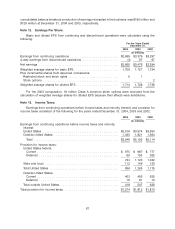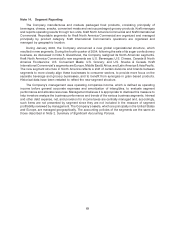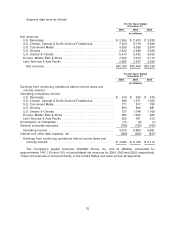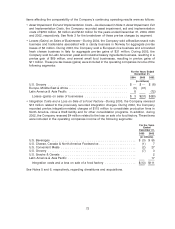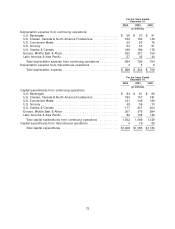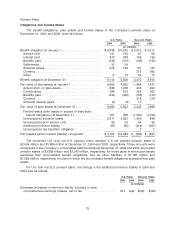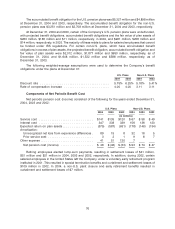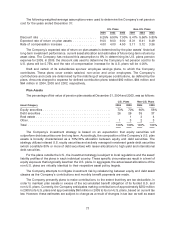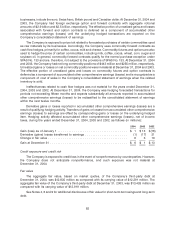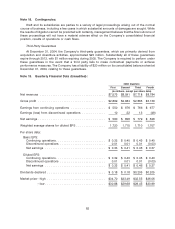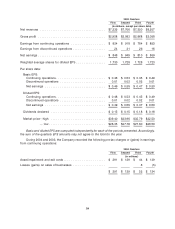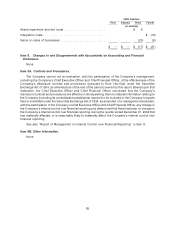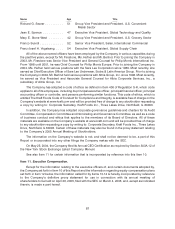Kraft 2004 Annual Report Download - page 78
Download and view the complete annual report
Please find page 78 of the 2004 Kraft annual report below. You can navigate through the pages in the report by either clicking on the pages listed below, or by using the keyword search tool below to find specific information within the annual report.
The following weighted-average assumptions were used to determine the Company’s net pension
cost for the years ended December 31:
U.S. Plans Non-U.S. Plans
2004 2003 2002 2004 2003 2002
Discount rate ............................... 6.25% 6.50% 7.00% 5.41% 5.56% 5.80%
Expected rate of return on plan assets ............. 9.00 9.00 9.00 8.31 8.41 8.49
Rate of compensation increase .................. 4.00 4.00 4.50 3.11 3.12 3.36
The Company’s expected rate of return on plan assets is determined by the plan assets’ historical
long-term investment performance, current asset allocation and estimates of future long-term returns by
asset class. The Company has reduced this assumption to 8% in determining its U.S. plans pension
expense for 2005. In 2005, the discount rate used to determine the Company’s net pension cost for its
U.S. plans will be 5.75% and the rate of compensation increase for its U.S. plans will be 4.00%.
Kraft and certain of its subsidiaries sponsor employee savings plans, to which the Company
contributes. These plans cover certain salaried, non-union and union employees. The Company’s
contributions and costs are determined by the matching of employee contributions, as defined by the
plans. Amounts charged to expense for defined contribution plans totaled $92 million, $84 million and
$64 million in 2004, 2003 and 2002, respectively.
Plan Assets
The percentage of fair value of pension plan assets at December 31, 2004 and 2003, was as follows:
U.S. Plans Non-U.S. Plans
Asset Category 2004 2003 2004 2003
Equity securities ..................................... 73% 70% 60% 56%
Debt securities ...................................... 26 26 35 37
Real estate ......................................... 1 3 4
Other ............................................. 1 3 2 3
Total ............................................. 100% 100% 100% 100%
The Company’s investment strategy is based on an expectation that equity securities will
outperform debt securities over the long term. Accordingly, the composition of the Company’s U.S. plan
assets is broadly characterized as a 70%/30% allocation between equity and debt securities. The
strategy utilizes indexed U.S. equity securities and actively managed investment grade debt securities
(which constitute 80% or more of debt securities) with lesser allocations to high yield and international
debt securities.
For the plans outside the U.S., the investment strategy is subject to local regulations and the asset/
liability profiles of the plans in each individual country. These specific circumstances result in a level of
equity exposure that is typically less than the U.S. plans. In aggregate, the actual asset allocations of the
non-U.S. plans are virtually identical to their respective asset policy targets.
The Company attempts to mitigate investment risk by rebalancing between equity and debt asset
classes as the Company’s contributions and monthly benefit payments are made.
The Company presently plans to make contributions, to the extent that they are tax deductible, in
order to maintain plan assets in excess of the accumulated benefit obligation of its funded U.S. and
non-U.S. plans. Currently, the Company anticipates making contributions of approximately $250 million
in 2005 to its U.S. plans and approximately $90 million in 2005 to its non-U.S. plans, based on current tax
law. However, these estimates are subject to change as a result of changes in tax law, as well as asset
77


